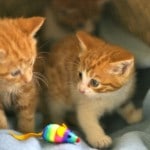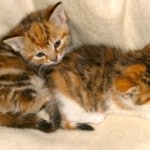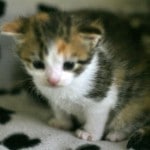Pet Advice Guides for Pet Owners
How to care for your new kitten
Hometime – The moment you’ve been waiting for has arrived and it’s time to take your new kitten home with you. This is quite a shock for the baby kit – one minute she’s with her mummy and her brothers and sisters, the next she’s in a strange place and with people she doesn’t really now. It’s amazing that kittens adapt to this big shake up! If you have two kittens it will be much easier and they will be company for each other. An ‘only child’ needs lots more fuss and care, the world is a big scary place to her and if you can keep her in a small area and close to you she will feel more confident. It’s always best to fetch your kitten when you have time to be with her for at least a few days. When she begins to get acclimatized it will be easier to leave her for a while. Cardboard boxes and fleecy cuddle blankets are essential, you can carry her around with you as much as you can but when you have to put the kitten down, a small box filled with a fleece will mimic her nest. A soft teddy will be a pretend friend for her and give her something to snuggle up to. Put the box in a warm place and free from draughts, we like to make a ‘kitten condo’ and cut in doors and windows, she’ll like to peek out and see what this new world looks like. When she is brave enough to explore she can run back to the safety of her little house whenever she likes.
Health check – Your kitten should be at least nine weeks old and have had her first vaccination before you get her. The vet will also have given her a health check before vaccinating her. Kittens need worming regularly and your vet is the best person to give you advice on this and provide you with the wormers. Many of the worming products you buy are not suitable for very young kittens, especially if they are small, so check this out. Kittens may need de-fleaing and Frontline is one of the sprays to deal with this, again your vet is the best person to recommend a product. In the past, kittens would be gone over with a flea comb and any parasites picked off – a pot of water will drown them or a blob of Vaseline immobilises them until you can get rid. It’s time consuming but it is safe and no possibly toxic chemicals are in use. There are also flea powders to sprinkle on to a young cat, I’m not so sure about these as if the kitten grooms she may ingest it. Again, check the instructions. Young kittens are vulnerable little creatures and need to be bigger and stronger before being exposed to strong chemicals.
Many kittens have ear mites. So do many adult cats. If the ear has brown matter inside and the cat/kit is scratching, then it’s likely to be ear mites. The vet will no doubt have spotted this and it’s a matter of putting prescribed oil into the ear until the mites have gone. Olive oil works too. The mites can cause a lot of damage to the ear if they are left but it’s a relatively simple matter to treat them.
Baby food – By nine weeks, kittens are enjoying their meals but it’s important to keep her on food she is accustomed to – changing diet might give her an upset tummy. If a kitten isn’t eating or has signs of upset she should be taken to the vet without delay. We feed our kits on Royal Canin Baby Cat complete biscuits and these are available for them all the time. They also have kitten pouches (not adult) offered three or four times a day – a small portion as much as they will eat only. They also like white fish, which is lightly cooked with a splash of goat’s milk. Make sure the fish is cooled to blood heat before putting it down. We only use fish that is sustainable and never give kittens salty or oily fish, although the latter is liked (and is good for them) when they are a bit older. Make sure all dishes are washed between meals and kept very clean, your kitten is still a baby and her immune system will not be fully developed. A saucer makes a good dish for a kitten, you don’t have to buy plastic or anything special. Plastic scratches easily and then harbours germs, there is nothing better than a small shallow china plate! Give the cat dishes a blast with boiling water to sterilize.
Clean and tidy – Is the kitten litter trained? We usually get asked this. The answer is that kittens litter train themselves, I’m sure their mothers would box their ears if they didn’t! The tiniest of kits will find her way to the nearest tray and climb in to go to the toilet. It’s the instinct to dig and then cover up. We always put lots of paper down too and some kits will ‘go’ on this if they can’t make it to the tray. Make sure it’s a shallow kitten tray and small size cat litter is best. Before the cat litter industry, people used to put earth or ashes from the fire in a metal tray or wooden box and this worked fine too. Perhaps a bit messy for today’s modern houses but if you have porches and sculleries and cellars, then it’s more acceptable. The litter tray has to be put fairly close to the kitten’s den. If she can’t find it then it will be a panic situation. As your kitten grows and gets used to the house and surroundings you can move the tray further away and nearer to the door.
No cow’s milk – We feed baby cat food until the kits are at least four months old, then they go on to kitten food until they are a year. We do have some big babies who like it even though they are a lot older! Never give cow’s milk to kittens as they can’t digest it. Not many animals can, even humans. It’s designed to rear a calf – that’s why. As your kit gets older you can introduce more variety in to the diet – finely chopped chicken or lamb, turkey or rabbit maybe and plenty of fish. You don’t have to feed factory manufactured food. A cat’s natural food would be rodents, rabbits, birds, bluebottles etc. and this is why cats have always been so highly valued, they kept our houses, farms and store places free from rats and mice.
Playtime – kittens are playful creatures and are especially pretty when they are leaping and jumping and chasing things. Don’t overdo it though. They need to play in their own time and for short periods only. Frantic chasing of sticks and pet shop toys makes for a hyped up pet, it can be stressful. Simple toys are best – small catnip mice, screwed up silver paper, feathers, leaves, ping pong balls and because you haven’t had to spend a lot of money on them they can be thrown away as soon as they are soiled. Don’t keep the same toy for ever – they harbour germs and should be either washed and sterilised or changed frequently. Your kitten might want to ‘find a friend’ to play with but she shouldn’t mix with other cats or kittens until her vaccinations are complete at twelve weeks old.
What’s in a name? The only thing left to do is to give the kitten a name and this is important. Get the name wrong and nothing ever seems to go right. Perhaps the kit’s personality will prompt it- a ball chasing boy might be a Beckham. A glamour puss could be Beyonce? The colour often gets it – Majolica – multi coloured like a painted plate or Japonica – a red tabby. Merle is smudgie coloured, Peaches is the exact colour of one, Naughty Tortie is a tortieshell although she’s now much too mature to be mischievous. Generally speaking a name that you don’t feel silly calling from the doorstep late at night is best – Manchester! United! It’s surprising how many cats are called after football clubs.




